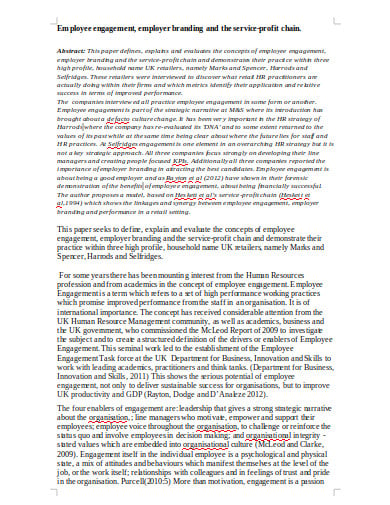Table of Contents
- 10+ Employer Branding Strategy Templates in PDF | Word
- 1. Employer Branding Strategy Template
- 2. Employer Branding Recruitment Strategy
- 3. Companies Employer Branding Strategy
- 4. Employer Branding HR Strategy
- 5. MNC Employer Branding Strategy
- 6. Employer Branding Strategy Example
- 7. IT Industry Employer Branding Strategy
- 8. Employer Branding Strategy to Attract
- 9. Employer Branding Strategic Dimension
- 10. Employer Branding Strategy in DOC
- 11. Professional Employer Branding Strategy
- What is the Importance of Employer Branding?
- What is HR Employer Branding?
- Why is Branding Beneficial?
- What is the Meaning of Employee Branding?
- Why is Employer Branding so Essential?
- How can Branding Help a Business?
- How Do You Create an Employer Branding Strategy?
10+ Employer Branding Strategy Templates in PDF | Word
What your employees, present and possible future job applicants think about you as an employer is referred to as an employer brand. It is their discernment of the way you approach your employees and candidates as well as your Employee Value Proposition. Have a look at the employer branding strategy templates provided down below and choose the one that best fits your purpose.

10+ Employer Branding Strategy Templates in PDF | Word
1. Employer Branding Strategy Template
 semanticscholar.org
semanticscholar.org2. Employer Branding Recruitment Strategy
 cornell.edu
cornell.edu3. Companies Employer Branding Strategy
 ac.uk
ac.uk4. Employer Branding HR Strategy
 lancaster.ac
lancaster.ac5. MNC Employer Branding Strategy
 ijemr.net
ijemr.net6. Employer Branding Strategy Example
 ac.id
ac.id7. IT Industry Employer Branding Strategy
 econstor.eu
econstor.eu8. Employer Branding Strategy to Attract
 ijrmbs.com
ijrmbs.com9. Employer Branding Strategic Dimension
 iiste.org
iiste.org10. Employer Branding Strategy in DOC
 arts.ac.uk
arts.ac.uk11. Professional Employer Branding Strategy
 researchgate.net
researchgate.net
What is the Importance of Employer Branding?
Employer branding will assist you to hire new employees, build a powerful organization culture and even lessen marketing costs. Having a prominent employer brand is a necessity for an organization’s approach because it benefits organizations to recruit better applicants, lessen hiring and marketing costs, and increase productivity.
What is HR Employer Branding?
The role of HR in building the employer brand is that HR is the look of an organization’s recruitment method and is frequently the first impact new employees have with your organization. HR also sets organization strategies that are nearly adjusted with the organization’s profits. Employer branding is not the responsibility of marketing or HR.
Why is Branding Beneficial?
Branding is necessary because not simply what makes it an enduring impact on customers but it permits your customers and clients to know what to anticipate from your organization. There are many sections that are used to improve a brand consisting of advertising, customer service, promotional commodities, reliability, and logo.
What is the Meaning of Employee Branding?
Employee branding develops employees’ performance so that they protrude the brand identification of their organization’s products through their everyday work behavior.
Why is Employer Branding so Essential?
Positive employer branding assists to draw and maintain quality employees, who are critical to the accomplishment and increase of the business. A great reason employer branding is so significant is it’s the business identity of your organization. It’s what makes your organization different or stand out to applicants who are looking for jobs.
How can Branding Help a Business?
A powerful, well-known brand can assist you to create the coming business, and even improve your business’ benefit by giving you more support in your industry. This makes it a more appealing investment chance because of its persistently fixed place in the marketplace.
How Do You Create an Employer Branding Strategy?
Following are some of the step-by-step points to assist improve your own employer branding approaches:
Employer branding activities might be deceived if long-term business requirements are not fully explained. Know what kinds of competencies the organization requires in order to deliver on the business plan.
Describe the central target groups. Determine the pressure between current and future talent, based on the business requirements and important competencies. Determine the central and secondary external target groups that need to be reached.
1. Understand the target groups
After determining the principal and secondary external and internal target groups, completely know them. Organizations should use analysis to know what these groups find engaging. Employers should also know the target groups’ present opinions of the organization and know which degree of the decision method they are in.
2. Optimize the employer value statement
An employer value proposition should be the framework for all external and internal connections with talent.
3. Select KPIs and set purposes
Once organizations know what is necessary to the business, get the target groups, and optimize the EVP, find means to estimate influence and to set goals.
4. Determine an optimal communication mix
The analysis shows which step of the decision method the target groups are in and this data will permit organizations to decide where the central focus should lie.
5. Build an annual plan
Many of the elements of a yearly employer branding plan which are the business needs, the target group’s description and penetrations, the EVP, the communication mix, the purposes, the main approaches, and the KPIs are now in place, so the plan begins to thicken.
6. Develop communication ideas
Based on the EVP and the chosen communication channels, organizations now need to improve communication purposes that will have the most prominent viable influence on the target groups and set the organization apart from the competition.
7. Execute and follow-up.
With the idea and express purposes in place, accomplish and continuously catch up.

